User Opinions
|
||||||||||
|
|
|
| Wed Feb 20, 2008 - 10:27 AM EST - By Andre Kibbe | |
|
|
|
|
|||||||||||
Note: Click on thumbnails to open pics full-size.
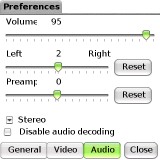
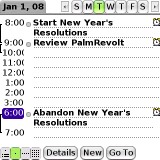
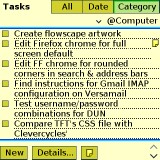
Sometimes when reading Palm forums or news I�ll run across a recurring complaint about the platform�s aging interface. It is, after all, fundamentally unchanged since 1996, notwithstanding upgrades to resolution and color. Customization is limited to selecting from a few basic fonts and a couple of dozen color themes, none of which comprise a radical makeover.
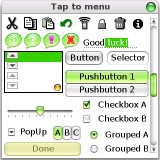
If stuck with the basic look of the Palm UI, I�d probably join the chorus, but I have to remind myself that these complaints usually come from users who aren�t using the skin engine that I�ve been using for the last two years: PalmRevolt.
PalmRevolt changes the look and feel of the Palm interface without affecting its functionality, as various app launchers would. An app like Ultimate Phone (read Harv's review) gives the Treo an almost completely new user environment. PalmRevolt�s only goal is to redesign the menus, fields and widgets of the standard UI. I personally prefer this subtle approach to Ultimate Phone�s usability alterations, some of which are a step forward, others a step back. I found myself disabling so many features on the latter app that I realized I might as well go back to the standard interface. All I really wanted was a new look, not a more novel mode of operation.
Like Google apps, all of PalmRevolt�s upgrades have officially remained in beta indefinitely. The current 0.95b version was released a week prior to this writing, and is the first update in over a year. Despite the beta designation, it runs like a stable version.
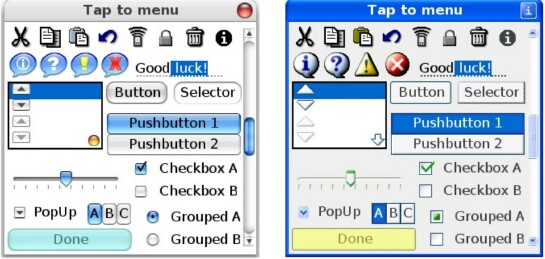
The download of PalmRevolt comes bundled with two skins: the MacOSXSkin and the WinXPBlueSkin. I�ve been using the Aqua(Green) skin, a variation on the blue MacOSXSkin, almost exclusively from the beginning. These skins are PRCs that must be installed manually, just like the app itself. Typically, the skins take about as much memory as the app (around 120kb), so installing many skins can quickly devour memory. Fortunately, the new version of PalmRevolt can compress the skins and store them on the Treo�s memory card.
More skins are available for download on 3GX�s site. 74 skins are currently featured. Typical of skin galleries, many of the skins are minor variations on each other, but there are probably more than a few to suit just about anyone�s taste. Most of my favorites are the ones that emulate various OS environments. There are skins for XP, Vista and even BeOS. Sorry, no Amiga skin yet.
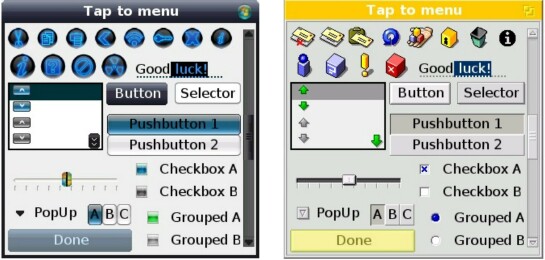
Some of the skins take some getting used to in terms of identifying the current focus during navigation. I used to have problems recognizing the highlighted element in an app with the Aqua(Green) theme. In Tasks, I would often select the Category tab when I meant to select the Category menu directly under it, since the menu turns pale when highlighted, while the tab is the darkest element.
Some apps, like Calc or Phone, aren�t changed substantially when applying PalmRevolt, due to the minimal number of standard UI elements these apps use. The visual impact of PalmRevolt varies from application to application, but is usually noticeable.
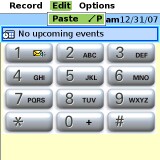
The PalmRevolt app consists of various configuration elements. The main field is the Exclusions window. Here you add the applications you would either like to exclude from being affected by PalmRevolt�s skinning, or would like to tweak further. Excluding an app may be necessary if it uses its own customized interface, as a game might; PalmRevolt can reportedly conflict with its operation (though I�ve never run into the problem). When an app is added to Exclusions, the listing has a checkbox to enable or disable its exclusion/modification.
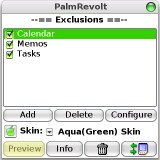
Modifications of apps in �Exclusions� (not the most accurate word for its function) are made by tapping the Configure button, opening the Application Preferences. By default, two parameters are checked: Enable Skin (if it was already checked in the Exclusion window) and High-Color mode by default. For some reason, there�s a Don�t skin the window title option.

The Fields menu allows you to either disable the appearance of lines from an application, or choose between thick or default line styles. If you select the �Nothing� parameter in Fields for the Memos app, for instance, each memo appears unruled (remember No Lines Hack?). I really like this setting.
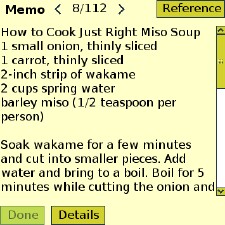
There�s a 5-Way menu that offers a selection of three settings: �Default behavior,� �Handled by PalmRevolt� and �Forced to PalmRevolt.� None of these settings seems to have any effect on how the 5-Way operates on the Treo. These parameters are probably designed for 5-Ways with different API handlers, like the Tungsten or Cli� models.
The app preferences also features a Color Theme menu, which either forces the skin to use its default color theme, the existing color theme selected in Palm Prefs, or the Original (dark blue on white) color theme.
Back on the main screen, the Skin menu is, of course, where the desired skin is selected. To see the look of all of the skins interface elements�buttons, menus, sliders, icons, etc.�tap the Preview button. The Info button displays whatever the skin�s author chooses to include: the recommended color theme to use for the skin, copyright and licensing information, or attributions to a previous theme that the current one modifies.
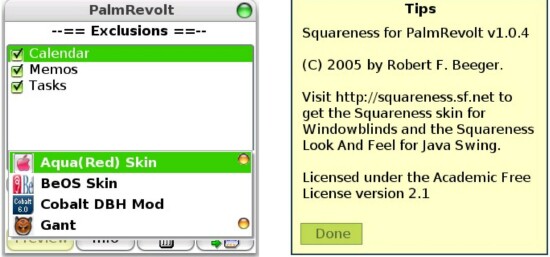
One welcome addition I noticed with 0.95 was the option in Preferences to Activate after Reset. Previously, whenever I had to soft reset the Treo, the interface would revert to its OEM state, and I�d have to manually reactivate PalmRevolt, often being required to reenter the reg code. I managed to avert this annoyance by installing Soft Reset, which allows me to specify which application starts after the reset, but it�s nice to know I no longer have to do that.
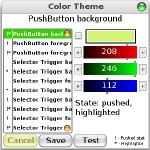
Another new feature is the Color Theme palette, allowing the user to change the RGB values for every single interface element. I had no idea that there were so many elements and parameters�e.g. PushButton background (State: pushed), PushButton background (State: pushed, highlighted), ad nauseum. Scrolling through and testing these can get pretty tedious, but if you can�t find an existing skin whose color scheme is tweaked to your idea of perfection, 10 or 15 minutes of trial and error here might be time well spent.
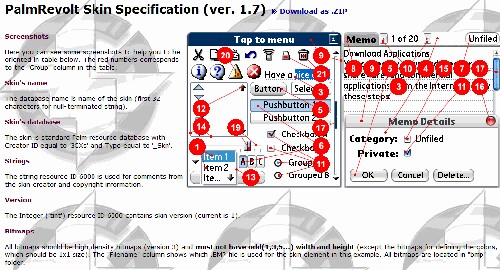
If you�re hardcore, you can take customizing to the next level by creating your own skins. The old Palm dev tool PilRC is the most labor intensive way to compile a new skin, and PFCD (The Palm File Compiler/Decompiler) isn�t much better. 3GX recommends Les Ateliers HP�s shareware HPSkin Studio for ease of use. 3GX�s site has the documentation necessary to create skins to PR�s specifications.
As mentioned, PalmRevolt only changes the look of the Palm UI, not its operation. Power users are likely to want something a little more �revolutionary� like ZLauncher or UltimatePhone. If you�re happy with the operational design of the standard interface, but would like to see some updating on the visual side, PalmRevolt is a better solution.
|
|
||||||||||||||||||||
|
Copyright 1999-2016 TreoCentral. All rights reserved :
Terms of Use : Privacy Policy
TREO and TreoCentral are trademarks or registered trademarks of palm, Inc. in the United States and other countries;
the TreoCentral mark and domain name are used under license from palm, Inc.
The views expressed on this website are solely those of the proprietor, or
contributors to the site, and do not necessarily reflect the views of palm, Inc.
Read Merciful by Casey Adolfsson